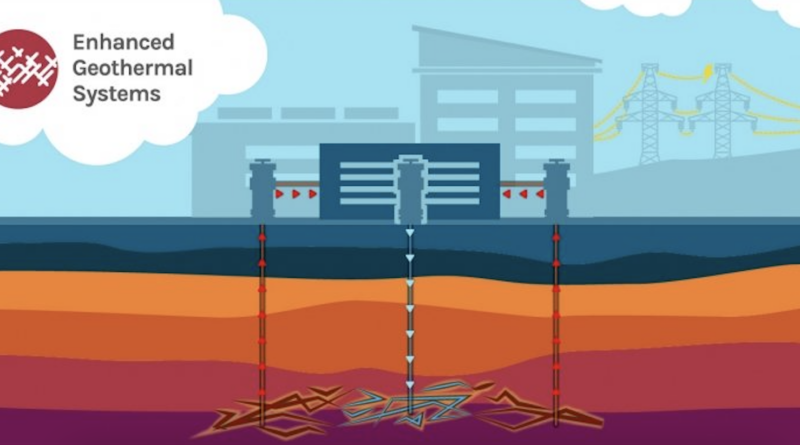
The opportunities to score a “gotcha” against Vice President Kamala Harris during her history-making campaign for President are few and far between, so it’s no surprise to see the Intertubes light up after a CNN interview revealed that she does not support a ban on fracking. Fracking is a controversial method for tapping into oil and gas deposits, and it is also the key to opening up vast reserves of clean, renewable geothermal energy lying just below the surface of the continental US, so ..
. what’s the problem? Seriously, though, fracking is no joke. Short for hydrofracturing or hydraulic fracturing, the practice involves pumping fluid into shale formations to grab oil and natural gas deposits that are inaccessible by conventional drilling methods.

As applied to oil and gas recovery, fracking was rare in the US until the technology improved and the Bush administration relaxed federal water protection standards in the early 2000’s, building on earlier de-risking exemptions for hydraulic fracturing that date back to the 1970’s. By the time former President Obama took office in 2009, all hell was breaking loose as the fracking boom took off, including stress on water resources , earthquakes related to wastewater disposal and to the operation itself, and significant public health impacts in local communities (see more fracking background here ). Somewhat ironically, oil and gas stakeholders have geothermal energy researchers to thank for the fracking boom.
On the heels of the 1970’s oil crisis, engineers at the US Department of Energy’s Sandia National Laboratories were tasked with applying their experience in the geothermal field to lend a hand to domestic oil and gas producers. “With support from the geothermal research program at the Department of Energy (DOE), in the 1980s Sandia engineers improved the General Electric’s 1970s PDC cutter and made it durable enough for oilfield use ,” reads an explainer issued by the lab. PDC refers to a p olycrystalline diamond material made up of particles bound together under pressure.
“PDC bits are now a key technology enabling economic drilling of extended-reach horizontal wells, which is standard practice for shale production,” Sandia reported. Meanwhile, interest in the new PDC bit failed to materialize among geothermal stakeholders . As recently as 2012, researchers attributed the no-show to the small size of the domestic geothermal energy industry.
Under a longstanding state of affairs, geothermal hotspots in the US have been limited to a few isolated areas west of the Rocky Mountains, except for one anomalous geothermal formation in West Virginia. Still, geothermal energy researchers were undeterred. Naturally occurring geothermal hotspots are limited to locations where fluid and porosity are present along with heat.
In contrast, fracking technology enables the creation of new, enhanced geothermal systems anywhere suitable hot rocks are present, by introducing the fluid and creating the porosity. If proven cost-effective in the market, enhanced geothermal systems would expand the US geothermal energy footprint by a wide margin, from a handful of gigawatts to more than 100 gigawatts according to a 2006 calculation by MIT. Back in 2014, CleanTechnica took note of new activity in the enhanced geothermal field , when the Energy Department issued funding for a suite of projects aimed at expanding geothermal energy access across the the US.
However, there were plenty of obstacles. In 2015, the agency’s Pacific Northwest National Laboratory ran down the state of affairs and noted that there is no such thing as a free lunch. “ Creating enhanced geothermal systems requires injecting millions of gallons of water – a valuable resource in the arid American West, where enhanced geothermal has the most potential,” PNNL advised.
“That water is sometimes mixed with a very small amount of chemicals to help the fluid better create and spread tiny cracks underground, which ultimately extends the life of a geothermal power plant,” the lab further observed, while cautioning that some of these treated “reservoir stimulation fluids” contain proprietary chemicals with potentially hazardous impacts. Treatment systems are in hand, but they add more expense to enhanced geothermal energy projects and expand the need for power, undercutting the economic case for geothermal development. PNNL also took note of one way to solve several problems at once: A new, non-toxic fluid consisting of 99% water and 1% polyallylamine, a carbon-nitrogen mashup similar to those used in medicine.
The idea is to pump the fluid into a well and follow up with an injection of pressurized carbon dioxide. “Within 20 seconds, the polyallylamine and carbon dioxide link together to form a hydrogel that expands the fluid up to 2.5 times its original volume,” ORNL relates.
“The swelling gel pushes against the rocks, causing existing cracks to expand while also creating new ones.” As described by ORNL, the hydrogel-enabled process only takes half the amount of water needed to open a new enhanced geothermal reservoir by ordinary means. They also noted that the hydrogel-forming process is reversible, opening up the potential for recycling the fluid.
All this is by way of saying that nine years later some of the kinks are yet to be worked out, but the Energy Department is determined to make enhanced geothermal happen. One recent development is the completion of the agency’s new FORGE geothermal research facility in Utah earlier this year, aimed specifically at fine tuning enhanced geothermal systems for the commercial market. Even before the facility was fully up and running, FORGE was already churning out actionable information about geothermal reservoir formation.
“Via preliminary tests, the Utah FORGE team has confirmed the connection between a newly drilled production well and the site’s existing injection well through a fracture system created during a multi-stage hydraulic fracturing process ,” the Energy Department reported in July of 2023. Meanwhile, industry stakeholders are not waiting around for the paint to dry. In one of the latest developments, last month Meta announced that it will deploy an enhanced geothermal system to power a proposed data center, to be located somewhere east of the Rocky Mountains (see more enhanced geothermal background here ).
As for aspiring President Kamala Harris’s stance on oil and gas fracking, that is consistent with the “all-of-the-above” energy policy of former President Barack Obama and current President Joe Biden, with whom she shares the Biden–Harris administration. Breaking with her own administration is an unforced error that would open up a can of energy policy worms, specifically in the neighboring swing states of Ohio and Pennsylvania. Gas stakeholders in those two states enjoyed federal support during the Obama administration, as part of an effort to replace lost coal jobs with a new petrochemicals hub leveraging regional gas supplies.
Last fall, the Biden–Harris administration upped the ante when the Energy Department tapped gas stakeholders in Ohio and Pennsylvania, along with West Virginia, to set up the new federally funded, $925 million Appalachian Regional Clean Hydrogen Hub (aka ARCH2). ARCH2 is one of seven new hubs designated by the Energy Department to develop a regionally diverse hydrogen supply chain. The other six hubs focus partly or entirely on extracting hydrogen from renewable or non-fossil resources .
ARCH2 won the right to focus exclusively on the natural gas supply chain because the 2021 Bipartisan Infrastructure Law, which provided the funds for the $7 billion Regional Clean Hydrogen Hubs program, stipulated a carve-out for hydrogen extracted from natural gas. Doing the math, there are probably more effective ways to win the hearts and minds of voters in Ohio and Pennsylvania without pulling the rug out from under an industry to which the Biden–Harris administration so recently threw $925 million in financial aid, on top of whatever the Obama administration chipped in. Besides, energy planners in Pennsylvania are already eyeballing at least two other new energy industries that will help keep more natural gas in the ground where it belongs.
The state’s eastern end has hooked up with Delaware and New Jersey to kickstart activity in the green hydrogen field, and policy makers are already planning for the geothermal energy business to expand into the state as well. If you have any thoughts about that, drop a note in the comment thread. Meanwhile, the organization Media Matters has some additional insights into that CNN interview in which Vice President Harris discusses her views on fracking.
Follow me via LinkTree , or @tinamcasey on Threads, LinkedIn, and Instagram. Image (cropped): Vice President Kamala Harris said a thing about fracking , a key technology for the US geothermal energy industry as well as the oil and gas industry (courtesy of US DOE). CleanTechnica's Comment Policy LinkedIn WhatsApp Facebook X Email Mastodon Reddit.














